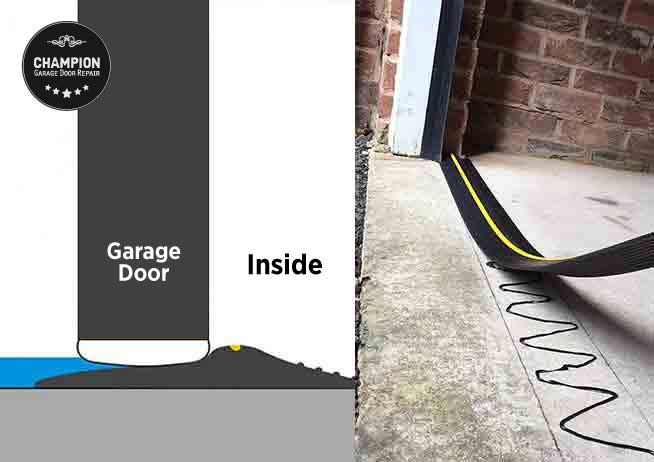Garages are designed for easy access, making them prone to flooding with impacts extending beyond the garage and its door. Floods can damage the foundations, destroy valuable belongings, and pose risks to lives if not managed effectively. This article explores common causes of garage flooding and offers effective strategies to protect your garage, garage door, and home from such occurrences.
Common Causes of Garage Flooding
- Heavy Rain and Atmospheric Rivers: Flash rain or prolonged rainfall, along with atmospheric rivers, are the leading causes of flooding in many regions of the country, including Orange County, California. When rainfall exceeds the ground’s absorption capacity or falls at a faster rate than the ground can handle, erosion occurs, resulting in flooding.
- Overflowing River: Overflowing rivers result from a significant rise in water levels, often exacerbated by global warming. Melting icebergs contribute to this rise, increasing the water levels of nearby rivers. Additionally, the melting of snow in a region can also contribute to overflowing rivers as the melted snow makes its way into the river simultaneously.
- Storm Surges and Tsunamis: These occur when a large body of water is rapidly displaced, sending wind and water waves to the surface. This displacement can be triggered by underwater earthquakes or volcanic eruptions. An example of this was the tsunami advisory that took effect on Saturday, January 15, 2022.
The 2022 Orange County Tsunami Advisory
The tsunami advisory was issued for all southern California beaches, including Huntington Beach, Manhattan Beach, Newport Beach, Newport Coast, Laguna Beach, Seal Beach, Long Beach, and all Orange County beaches. The National Weather Service for Los Angeles warned the public, especially those who live by the beach, to be cautious of tsunami waves, potentially caused by the Hunga-Tonga-Hunga-Ha’apai volcano eruption, which caused tsunami waves across the Pacific Ocean.
The City of Huntington Beach twitted the tsunami advisory at around 7 a.m. on January 15, 2022. The tweet was also quoted by the Huntington Beach police department less than five minutes later, warning against strong currents and waves. The Newport Beach Police Department announced the tsunami advisory and the subsequent closing of its beach and pier. Announcement also made by the Seal Beach Police Department.
While the tsunami advisory was lifted shortly after, it emphasizes the reality that natural disasters can occur rapidly and without warning, highlighting the importance of implementing proactive measures before flooding transpires.
How to Prepare and Protect Your Garage from Floods
Approximately 25% of all flood damage occurs in low-risk zones, so even if you don’t live in a high-risk area, the following steps can help you protect your garage and home from flooding.
- Compliance with the Required Elevation: Ensure that utilities such as electrical, gas lines, water heaters, heating, and air conditioning are elevated or designed and installed to prevent the intrusion of floodwater in compliance with the required elevation standards.
- Repair Cracks and Holes in the Garage: Check the garage walls, floor, and ceiling for cracks or holes. Clean the area by sweeping away debris and ensuring the surface is free of oil, grease, or any other substances that could prevent the filler from hardening. Use appropriate fillers to patch the cracks. Replace any leaking roof sheets as necessary.
- Reinforce Building Components: Garages and homes in coastal areas may face high winds, waves, and floodwater. Therefore, their structural components should be connected together and reinforced.
- Install French Drains around Your Garage: If your home’s current drainage system is inadequate, consider installing French Drains or Weeping Tiles around your garage and property. These drains will help divert excess water away from your garage and land.
- Use Flood Barriers: Flood barriers act as dams to prevent water from flowing towards your garage and home. These barriers can be constructed from designated panels made of composite materials or simply sandbags, which are commonly used in residential settings. To improve a sandbag barrier, place thick fabric materials such as towels or heavy clothing behind it to absorb any water that may penetrate through.
- Insall Flood Vents: Flood vents are designed to prevent pressure buildup by enabling floodwater to flow through your garage or home. Instead of resisting strong forces like hydrostatic pressure, flood vents help mitigate damage to walls and foundations by allowing floodwater pressure to pass through and directing it towards a drainage system. Properties located in Zone-A, which are at high risk of flooding, are required to have flood openings in the foundation walls of their garages.
- Weatherproof the Garage Door: Garage door weather stripping is typically made of vinyl and designed to prevent water, insects, dust, and debris from entering the garage. Inspect the weather strips to ensure that the seals are in good condition and not dry or crumbling. Verify that the garage frame and door are adequately sealed at the bottom and edges. Follow the steps below to fix any gaps.
Predicting the precise timing of flooding caused by natural events is challenging. Start by understanding the building codes and requirements determined by the Base Flood Elevation (BFE) in your area, and determine if you’re in a flood hazard zone by contacting FEMA.
Fix Gaps Between the Garage Door and Floor
If there is a gap when the door is fully closed, start by adjusting the travel settings of the electric door opener. Otherwise, the door may require rebalancing, realignment, or replacement of the bottom seal. If the garage floor is uneven, use a bigger bottom seal or a storm shield.

In more complicated situations, repairs may be needed for the concrete floor or shifting foundations.
Fix Gaps Between the Garage Door and Frame
There are three effective methods to address gaps between the garage door and the frame:
- Loosen the nut securing the garage door vertical tracks to the jamb bracket. Then, push the tracks closer to the frame and tighten the nut once the tracks are in the desired position.
- Remove the trim/moldings from the garage frame and reinstall them closer to the garage door.
- Replace the hinges on both sides of the garage door with higher hinge numbers (no need to replace intermediate hinges). A higher hinge number will push the garage door further towards the frame.
After fixing the gaps, manually operate the door to ensure there is no excessive binding between the garage door and the frame when opening and closing. Readjust if necessary.
Prepare Garage Doors for Emergencies
Follow these steps to proactively ensure that garage doors are prepared for emergency use:
- Regularly inspect the balance and springs of your garage door. Consider replacing garage door springs that are more than four to five years old.
- Inspect and properly maintain the moving parts of the garage door, including rollers, cables, bearings, and pulleys. Ensure they are lubricated periodically and address irregular noises in a timely manner.
- Perform routine testing of electric garage door openers. Test the emergency manual release feature and check the backup battery, which required by law for residential properties in California.
The most effective way to maintain accessibility and ensure your garage remains in good repair is by regularly maintaining your garage doors and openers. Consult a licensed garage door repair company for assistance.
Protecting Your Garage Against Floods
Authorities utilize various tools and methods to communicate important information to us before, during, and after emergencies or disasters. Being prepared for natural disasters such as floods or earthquakes before they occur is essential to avoid being caught off guard in an emergency. Always ensure the garage and garage doors are in good repair, that the garage is accessible, and your properties and homes comply with FEMA guidelines.







